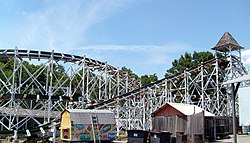
A roller coaster is a type of amusement ride employing a form of elevated railroad track that carries passengers on a train through tight turns, steep slopes, and other elements usually designed to produce a thrilling experience. Trains consist of open cars connected in a single line, and the rides are often found in theme parks around the world. Roller coasters first appeared in the 17th century, and LaMarcus Adna Thompson obtained one of the first known patents for a roller coaster design in 1885, based on the Switchback Railway which opened a year earlier at Coney Island.

Kennywood is an amusement park which is located in West Mifflin, Pennsylvania, just southeast of Pittsburgh. The park opened on May 30, 1898, as a trolley park attraction at the end of the Mellon family's Monongahela Street Railway.
Cedar Point is a 364-acre (147 ha) amusement park located on a Lake Erie peninsula in Sandusky, Ohio, United States. It opened in 1870 and is considered the second-oldest operating amusement park in the US behind Lake Compounce. Cedar Point, which is owned and operated by Cedar Fair, is the flagship of the company's amusement park chain. Known as "America's Roller Coast", the park features 17 roller coasters, which ranks third among amusement parks in North America behind Canada's Wonderland (18) and Six Flags Magic Mountain (20).

A wooden roller coaster is a type of roller coaster classified by its wooden track, which consists of running rails made of flat steel strips mounted on laminated wood. The support structure is also typically made of wood, but may also be made of steel lattice or truss, which has no bearing on a wooden coaster's classification. The type of wood often selected in the construction of wooden coasters worldwide is southern yellow pine, which grows abundantly in the southern United States, due to its density and adherence to different forms of pressure treatment.

Philadelphia Toboggan Coasters (PTC) is one of the oldest existing roller coaster manufacturing companies in the world. Based in Hatfield, Pennsylvania, it was established in 1904 by Henry Auchey and Chester Albright under the name Philadelphia Toboggan Company. The company manufactured carousels, wooden roller coasters, toboggans and later, roller coaster trains.
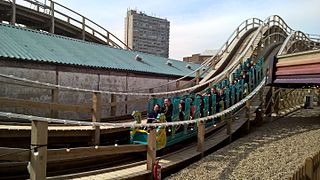
The Scenic Railway is a wooden roller coaster located at the Dreamland Amusement Park in Margate, United Kingdom. It first opened in 1920 and is the oldest roller coaster in the UK. The ride is distinctive compared to modern-day roller coasters, as a brakeman is still required to travel with the train to control its speed, manually applying brakes when needed. It is also one of only eight scenic railways in the world, and the UK's English Heritage granted the roller coaster Grade II listed status in 2002 and Grade II* listed status in 2011. The Scenic Railway was non-operational from 2006 until 2015 amid park closure and restoration following an arson attack.

A roller coaster train is a vehicle made up of two or more carts connected by specialized joints which transports passengers around a roller coaster's circuit. Roller coasters usually have various safety features, including specialized wheels and restraints.
A side friction roller coaster is an early roller coaster design invented by Edward Joy Morris. The design introduced side-friction wheels to help prevent trains from derailing during curved portions of the track. In addition to weight-bearing wheels traditionally located on the underside of each train car, friction wheels were added to both sides, which roll perpendicular along the inner edge of the track.

The Cyclone, also called the Coney Island Cyclone, is a wooden roller coaster at Luna Park in Coney Island, Brooklyn, New York City. Designed by Vernon Keenan, it opened to the public on June 26, 1927. The roller coaster is on a plot of land at the intersection of Surf Avenue and West 10th Street. The Cyclone reaches a maximum speed of 60 miles per hour (97 km/h) and has a total track length of 2,640 feet (800 m), with a maximum height of 85 feet (26 m).
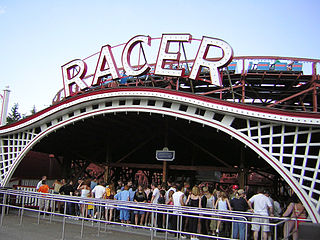
Racer is a wooden racing roller coaster located at Kennywood amusement park in West Mifflin, Pennsylvania. Built by Charlie Mach and designed by John A. Miller, Racer opened to the public in 1927 and is one of the oldest operating roller coasters in the world.

American Coaster Enthusiasts (ACE) is a non-profit organization focusing on the enjoyment, knowledge, and preservation of roller coasters as well as recognition of some as architectural and engineering landmarks. Dues-paying members receive the quarterly magazine RollerCoaster! and bi-monthly newsletter ACE News. Amusement parks have also invited members to exclusive ride events at amusement parks as well as sneak peek events at new roller coasters under construction.

Seabreeze Amusement Park (Seabreeze) is a historic family amusement park located in Irondequoit, New York, a suburb of Rochester, where Irondequoit Bay meets Lake Ontario. According to the National Amusement Park Historical Association (NAPHA), Seabreeze is the fourth-oldest operating amusement park in the United States and the thirteenth-oldest operating amusement park in the world, having opened in 1879. The park features roller coasters, a variety of other rides, a midway, and a water park.
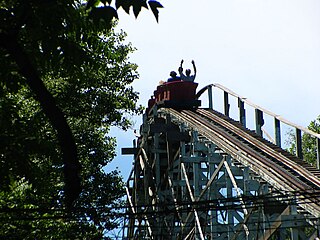
Blue Streak was a wooden roller coaster built in 1938 at Conneaut Lake Park in Conneaut Lake, Pennsylvania. It was the only wooden coaster operating in the park, as well as the largest. Blue Streak followed an out and back design. It was the 17th oldest wooden roller coaster in the United States, and it was one of two shallow coasters designed by Ed Vettel still operating until 2021. Blue Streak opened in 1938, and operated inconsistently until 2019. It stood out of operation until 2022, when it was destroyed in a fire during demolition.

The Wild One is a wooden roller coaster at Six Flags America in Prince George's County, Maryland. It features a 450° spiral helix and a series of bunny hills that produce a significant amount of air time. The wooden coaster was previously known as Giant Coaster when it was located at Paragon Park in Hull, Massachusetts. It operated there from 1917 to 1984. It is the oldest coaster in any Six Flags park.

Lakemont Park is an amusement park located in Altoona, Pennsylvania. The park opened in 1894 as a trolley park and became an amusement park in 1899. It is one of only thirteen trolley parks still operating, and the 8th oldest amusement park in the United States. The park was closed from 2017 to 2018, but re-opened in summer 2019. It will be closed for the 2024 season.
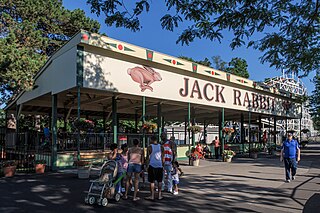
Jack Rabbit is an "out and back" wooden roller coaster located at Seabreeze Amusement Park in Irondequoit, New York. The Jack Rabbit is a terrain coaster that features seven dips, a helix, and a tunnel. It opened on May 31, 1920. Jack Rabbit is the fourth oldest operating roller coaster in the world and the second oldest in the United States. The oldest, Leap-The-Dips in Altoona, Pennsylvania, was closed from 1985 to 1999, making Jack Rabbit the oldest continuously operating coaster in the country.

Skyliner is a wooden roller coaster located at Lakemont Park in Altoona, Pennsylvania. It first opened in 1960 at New York's Roseland Park, and was John C. Allen's first full-size coaster design. Roseland Park closed in 1985, and following the success Knoebels had in relocating wooden coaster Phoenix, Lakemont Park followed suit. Skyliner reopened at Lakemont Park in 1987 after being moved from Roseland Park. Skyliner is an ACE Coaster Classic. The ride is not operating for the 2024 season.

Toboggan was a steel roller coaster located at Lakemont Park in Altoona, Pennsylvania. It was a portable steel coaster built by Chance Rides, and was one of many of their Toboggan installations across the United States. This specific Toboggan had previously traveled in Florida with Deggeller Shows.
Figure 8 roller coasters are a category of roller coasters where the train runs through a figure 8 shaped course before returning to the boarding station. This design was one of the first designs to be featured in roller coaster design, along with the out and back roller coaster. The figure 8 design allowed for more turns than the out and back design, offering riders an alternative experience.
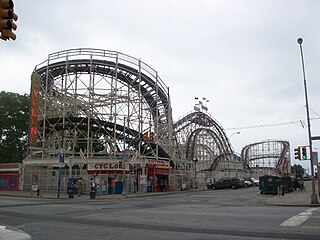
Roller coaster amusement rides have origins back to ice slides constructed in 18th-century Russia. Early technology featured sleds or wheeled carts that were sent down hills of snow reinforced by wooden supports. The technology evolved in the 19th century to feature railroad track using wheeled cars that were securely locked to the track. Newer innovations emerged in the early 20th century with side friction and underfriction technologies to allow for greater speeds and sharper turns. By the mid-to-late 20th century, these elements intensified with the introduction of steel roller coaster designs and the ability to invert riders.
